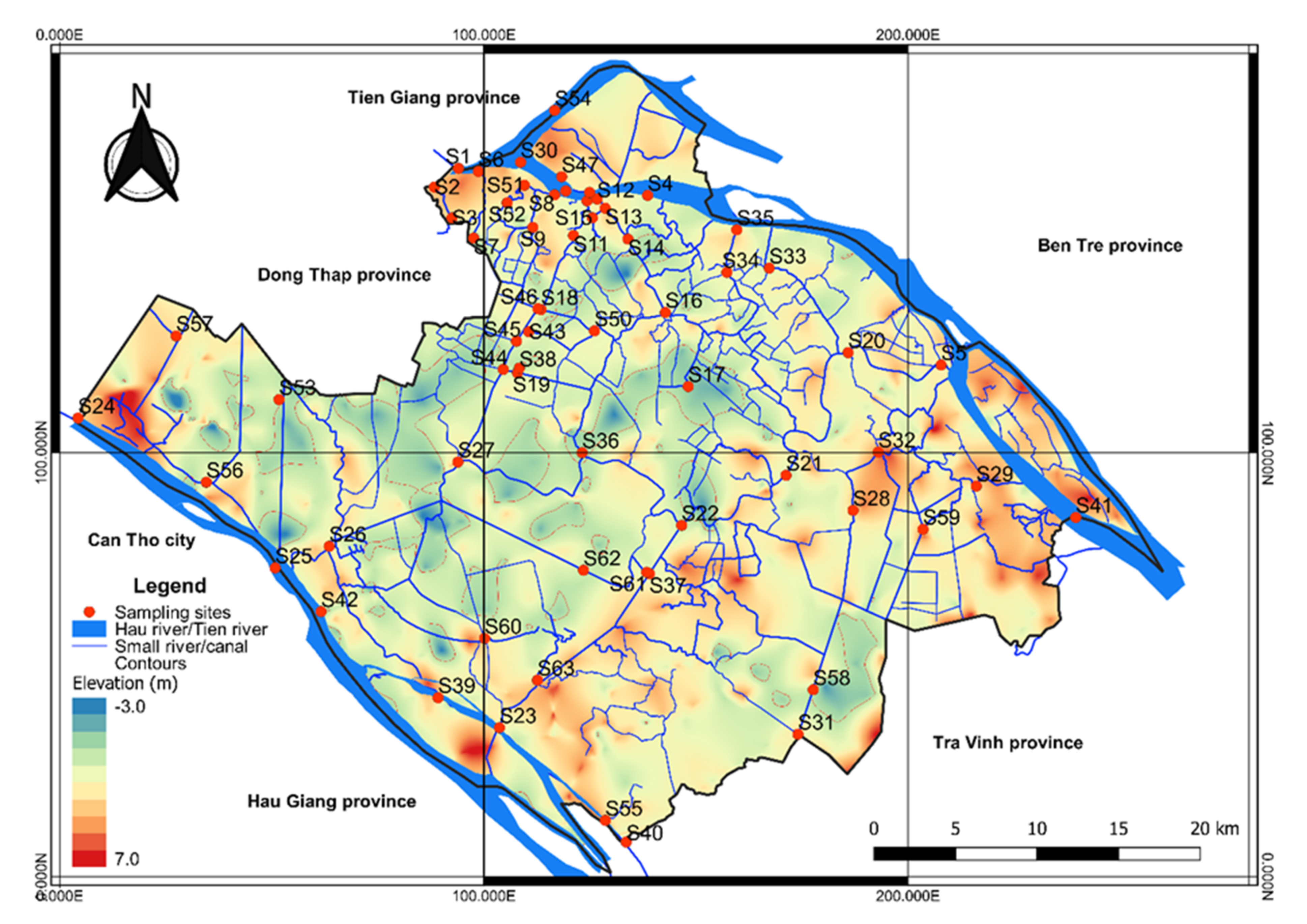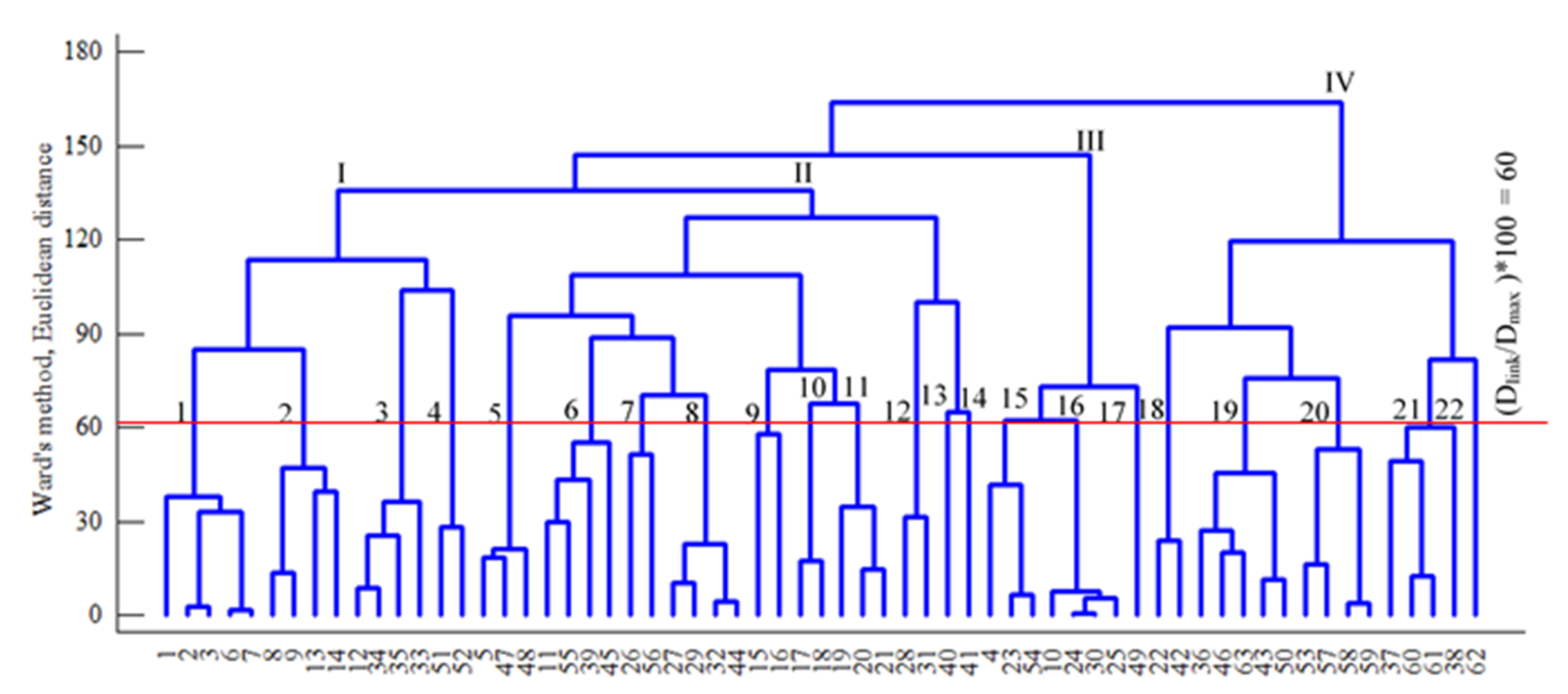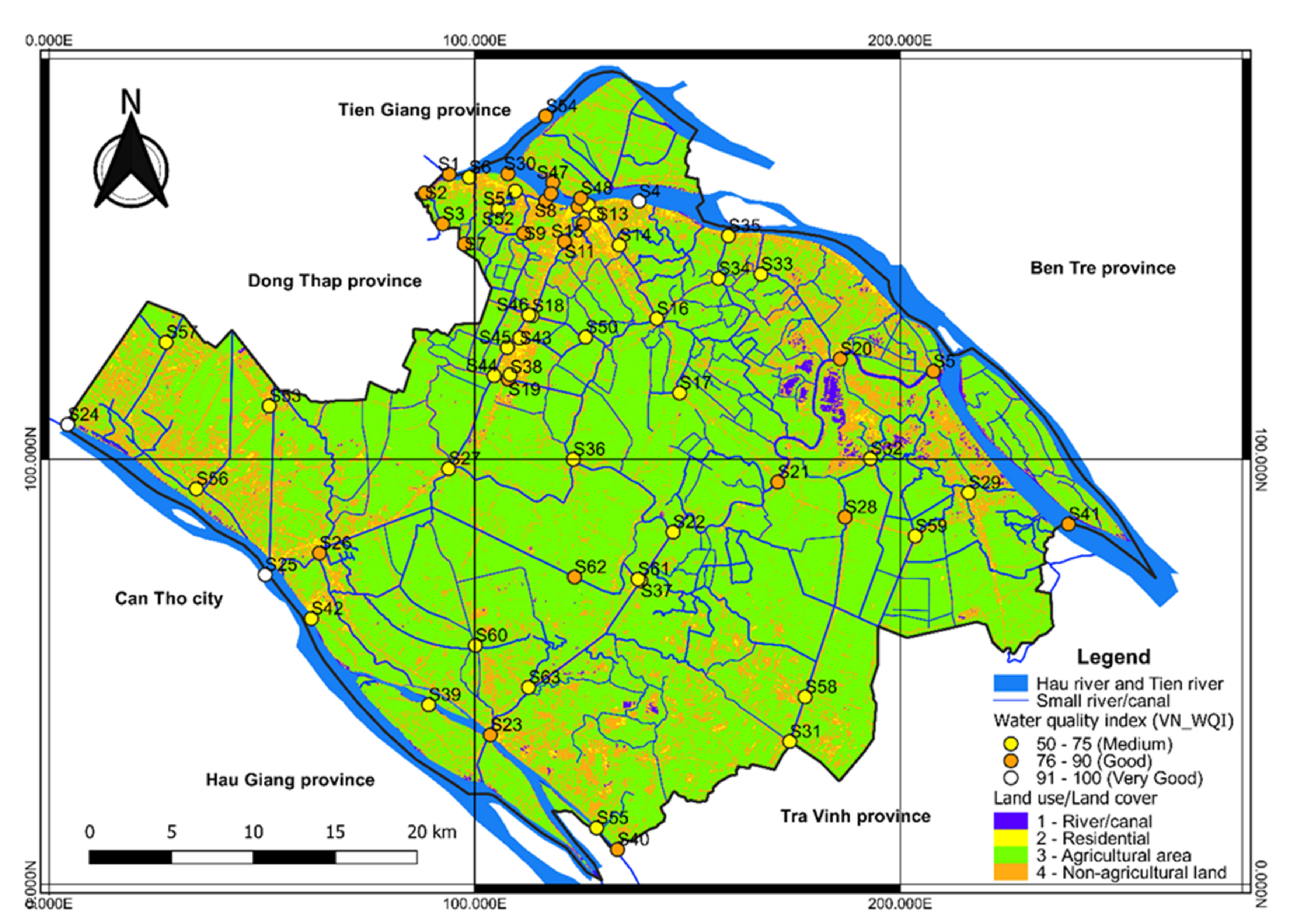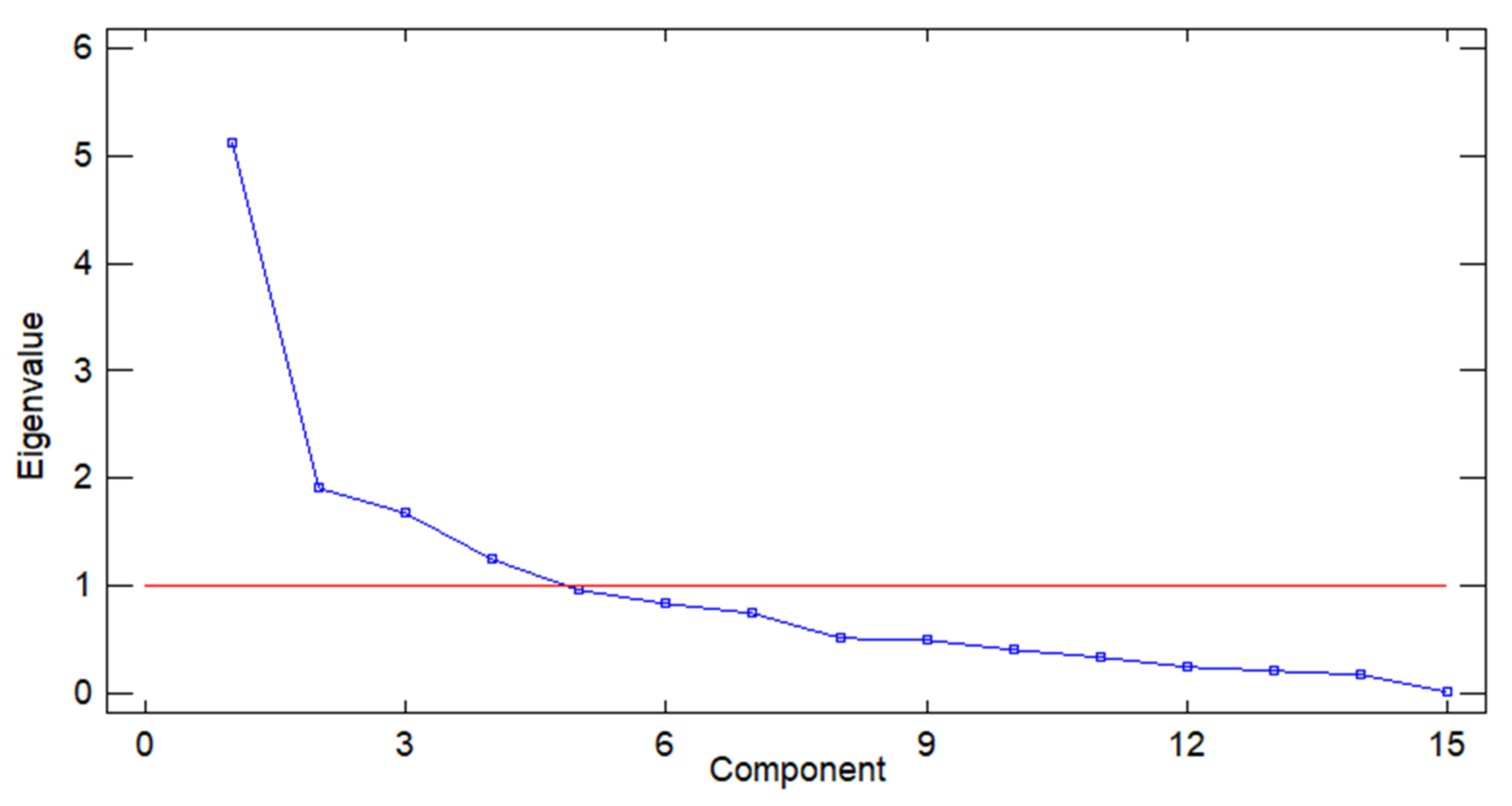Spatiotemporal Variations in Physicochemical and Biological Properties of Surface Water Using Statistical Analyses in Vinh Long Province, Vietnam
Abstract
:1. Introduction
2. Materials and Methods
2.1. Study Areas
2.2. Water Sample Collection and Analysis
2.3. Data Processing
2.3.1. Integrated Water Quality Assessment Method
2.3.2. Calculation of Entropy Weight
2.3.3. Multivariate Statistical Methods
3. Results
3.1. Water Quality Characteristics in Vinh Long Province
3.2. Temporal Variations in Surface Water Quality
3.3. Clustering Surface Water Quality and Water Quality Index
3.4. Ranking and Correlating Surface Water Quality Parameters
3.5. Key Variables Influencing Surface Water Quality
4. Discussion
4.1. Water Quality Characteristics in Vinh Long Province
4.2. Temporal Variation of Surface Water Quality
4.3. Clustering Surface Water Quality and Water Quality Index
4.4. Ranking and Correlating Surface Water Quality Parameters
4.5. Key Variables Influencing Surface Water Quality
5. Conclusions
Author Contributions
Funding
Institutional Review Board Statement
Informed Consent Statement
Data Availability Statement
Acknowledgments
Conflicts of Interest
References
- O’Donoghue, C.; Buckley, C.; Chyzheuskaya, A.; Green, S.; Howley, P.; Hynes, S.; Upton, V.; Ryan, M. The spatial impact of rural economic change on river water quality. Land Use Policy 2021, 103, 105322. [Google Scholar] [CrossRef]
- Jarvie, H.P.; Whitton, B.A.; Neal, C. Nitrogen and phosphorus in east coast British rivers: Speciation, sources and biological significance. Sci. Total Environ. 1998, 210, 79–109. [Google Scholar] [CrossRef]
- Carpenter, S.R.; Caraco, N.F.; Correll, D.L.; Howarth, R.W.; Sharpley, A.N.; Smith, V.H. Nonpoint pollution of surface waters with phosphorus and nitrogen. Ecol. Appl. 1998, 8, 559–568. [Google Scholar] [CrossRef]
- Mekong River Commission (MRC). Annual Water Quality Data Assessment Report, 2013. MRC Technical Paper No.40. Available online: https://www.mrcmekong.org/resource/ajgsdy (accessed on 19 April 2022).
- Pak, H.Y.; Chuah, C.J.; Yong, E.L.; Snyder, S.A. Effects of land use configuration, seasonality and point source on water quality in a tropical watershed: A case study of the Johor River Basin. Sci. Total Environ. 2021, 780, 146661. [Google Scholar] [CrossRef]
- Deaths from Dirty Water and Related Diseases. Available online: https://www.theworldcounts.com/challenges/planet-earth/freshwater/deaths-from-dirty-water/story (accessed on 19 April 2022).
- National Assembly. Law on Environmental Protection; National Assembly: Ha Noi, Vietnam, 2014.
- Giau, V.T.N.; Tuyen, P.T.B.; Trung, N.H. Assessing surface water quality of Can Tho river in the period of 2010–2014 using water quality indicator (WQI). Can Tho Univ. J. Sci. 2019, 55, 105–113. [Google Scholar]
- Truc, D.T.; Phat, P.H.; Nam, N.D.G.; Toan, P.V.; Tri, V.P.D. Surface water quality of Tien River flowing through Tan Chau area, An Giang province. Can Tho Univ. J. Sci. 2019, 55, 53–60. [Google Scholar]
- Sharma, M.; Kansal, A.; Jain, S.; Sharma, P. Application of multivariate statistical techniques in determining the spatial temporal water quality variation of Ganga and Yamuna rivers present in Uttarakhand State, India. Water Qual. Expo. Health 2015, 7, 567–581. [Google Scholar] [CrossRef]
- Sharma, V.; Sharma, M.; Panita, S.; Kumar, V.; Kour, J.; Sharma, N. Assessment of water quality using different pollution indices and multivariate statistical techniques. In Heavy Metals in the Environment; Charlotte, K., Ed.; Elsevier: Amsterdam, The Netherlands, 2021; pp. 165–178. [Google Scholar]
- Giao, N.T. Spatial variations of surface water quality in Hau Giang province, Vietnam using multivariate statistical techniques. Environ. Nat. Resour. J. 2020, 18, 400–410. [Google Scholar] [CrossRef]
- Cao, P.N.D.V.; Van, D.T.; Duong, V.H. The result of research about surface water pollution, eutrophication in some channels connecting Tien and Hau rivers in Vinh Long, Dong Thap, Tien Giang provinces. Sci. Technol. J. Agric. Rural Dev. 2009, 8, 50–56. [Google Scholar]
- Thanh, G.N. Urban wastewater quality in Vinh Long province, Vietnam. Sci. J. Nat. Resour. Environ. 2021, 39, 3–15. [Google Scholar]
- APHA. Standard Methods of for the Examination of Water and Wastewater, 23rd ed.; American Public Health Association: Washington, DC, USA, 2017. [Google Scholar]
- Vietnam Environment Administration. Decision 1460/QD-TCMT Dated November 12, 2019 on the Issuing of Technical Guide to Calculation and Disclosure Vietnam Water Quality Index (VN_WQI); Vietnam Environment Administration: Hanoi, Vietnam, 2019. [Google Scholar]
- Singh, K.R.; Dutta, R.; Kalamdhad, A.S.; Kumar, B. Information entropy as a tool in surface water quality assessment. Environ. Earth Sci. 2019, 15, 78. [Google Scholar] [CrossRef]
- Islam, A.M.T.; Al-Mamun, A.; Rahman, M.M.; Zahid, A. Simultaneous comparison of modified-integrated water quality and entropy weighted indices: Implication for safe drinking water in the coastal region of Bangladesh. Ecol. Indic. 2020, 113, 106229. [Google Scholar] [CrossRef]
- Liu, Y.; Hu, Y.; Hu, Y.; Gao, Y.; Liu, Z. Water quality characteristics and assessment of Yongding New River by improved comprehensive water quality identification index based on game theory. Res. J. Environ. Sci. 2021, 104, 40–52. [Google Scholar] [CrossRef] [PubMed]
- Thu, T.; Le, H.; Zeunert, S.; Lorenz, M.; Meon, G. Multivariate statistical assessment of a polluted river under nitrification inhibition in the tropics. Environ. Sci. Pollut. Res. 2017, 24, 13845–13862. [Google Scholar]
- Li, M.; Liu, Z.; Zhang, M.; Chen, Y. A workflow for spatio-seasonal hydro-chemical analysis using multivariate statistical techniques. Water Res. 2021, 188, 116550. [Google Scholar] [CrossRef]
- Shrestha, S.; Kazama, F. Assessment of surface water quality using multivariate statistical techniques: A case study of the Fuji River basin, Japan. Environ. Model. Softw. 2007, 22, 464–475. [Google Scholar] [CrossRef]
- Chounlamany, V.; Tanchuling, M.A.; Inoue, T. Spatial and temporal variation of water quality of a segment of Marikina River using multivariate statistical methods. Water Sci. Technol. 2017, 76, 1510–1522. [Google Scholar] [CrossRef]
- Ministry of Natural Resources and Environment. National Technical Regulation on Surface Water Quality (QCVN 08-2015/BTNMT); Ministry of Natural Resources and Environment: Hanoi, Vietnam, 2015.
- Nguyen, P.Q.; Le, H.Y.; Cong, N.V.; Phu, T.Q. Variation of some water quality parameters in intensive cultured catfish (Pangasianodon hypopthalmus) ponds. Can Tho Univ. Sci. J. 2014, 34, 128–136. [Google Scholar]
- Giao, N.T. Surface water quality at the branches adjacent to Hau River in Can Tho city. J. Agric. Rural Dev. 2020, 15, 79–86. [Google Scholar]
- Giao, N.T.; Nhien, H.T.H.; Anh, P.K.; Ni, D.V. Classification of water quality in low-lying area in Vietnamese Mekong delta using set pair analysis method and Vietnamese water quality index. Environ. Monit. Assess. 2021, 193, 319. [Google Scholar] [CrossRef]
- Giao, N.T.; Cong, N.V.; Nhien, H.T.H. Using remote sensing and multivariate statistics in analyzing the relationship between land use pattern and water quality in Tien Giang province, Vietnam. Water 2021, 13, 1093. [Google Scholar] [CrossRef]
- Conductivity. Available online: https://archive.epa.gov/water/archive/web/html/vms59.html (accessed on 19 April 2022).
- Giao, N.T.; Nhien, H.T.H. Phytoplankton-water quality relationship in water bodies in the Mekong Delta, Vietnam. Appl. Environ. Res. 2020, 42, 1–12. [Google Scholar] [CrossRef] [Green Version]
- Ustaoğlu, F.; Tepe, Y. Water quality and sediment contamination assessment of Pazarsuyu Stream, Turkey using multivariate statistical methods and pollution indicators. Int. Soil Water Conserv. Res. 2019, 7, 47–56. [Google Scholar] [CrossRef]
- Giao, N.T.; Nhien, H.T.H. Evaluating water quality variation in the Vietnamese Mekong Delta area using cluster and discriminant analysis. Appl. Environ. Res. 2021, 43, 14–27. [Google Scholar]
- Alberto, W.D.; Pilar, D.M.; Valeria, A.M.; Fabiana, P.S.; Cecilia, H.A.; Angeles, B.M. Pattern recognition techniques for the evaluation of spatial and temporal variations in water quality. A case study: Suquía River Basin (Córdoba–Argentina). Water Res. 2001, 35, 2881–2894. [Google Scholar] [CrossRef]
- Voza, D.; Vuković, M. The assessment and prediction of temporal variations in surface water quality—A case study. Environ. Monit. Assess. 2018, 190, 434. [Google Scholar] [CrossRef]
- Lien, N.T.K.; Huy, L.Q.; Oanh, D.T.H.; Phu, T.Q.; Ut, V.N. Water quality in mainstream and tributaries of Hau River. Can Tho Univ. J. Sci. 2016, 43, 68–79. [Google Scholar]
- Cheng, P.; Meng, F.; Wang, Y.; Zhang, L.; Yang, Q.; Jiang, M. The impacts of land use patterns on water quality in a trans-Boundary River basin in Northeast China based on eco-functional regionalization. Int. J. Environ. Res. Public Health 2018, 15, 1872. [Google Scholar] [CrossRef] [Green Version]
- Varol, M.; Li, S. Biotic and abiotic controls on CO2 partial pressure and CO2 emission in the Tigris River, Turkey. Chem. Geol. 2017, 449, 182–193. [Google Scholar] [CrossRef]
- Dixit, S.; Tiwari, S. Effective utilization of an aquatic weed in an eco-friendly treatment of polluted water bodies. J. Appl. Sci. Environ. 2007, 11, 41–44. [Google Scholar] [CrossRef] [Green Version]








| Methods | Function | Eigenvalue | %Variation | Canonical Correlation | Wilks Lambda | Chi-Square | p-Value |
|---|---|---|---|---|---|---|---|
| Standard | 1 | 1.73 | 90.64 | 0.80 | 0.31 | 209.32 | 0.00 |
| 2 | 0.18 | 9.36 | 0.39 | 0.85 | 29.45 | 0.01 | |
| Forward stepwise | 1 | 1.69 | 91.50 | 0.79 | 0.32 | 206.82 | 0.00 |
| 2 | 0.16 | 8.50 | 0.37 | 0.86 | 26.57 | 0.00 | |
| Backward stepwise | 1 | 1.71 | 91.17 | 0.79 | 0.32 | 208.62 | 0.00 |
| 2 | 0.17 | 8.81 | 0.38 | 0.86 | 27.80 | 0.00 |
| Parameter | Standard | Forward Stepwise | Backward Stepwise | ||||||
|---|---|---|---|---|---|---|---|---|---|
| March | June | September | March | June | September | March | June | September | |
| pH | 68.08 | 66.83 | 68.63 | 62.14 | 60.85 | 62.78 | 62.53 | 61.26 | 63.16 |
| Temp | 36.42 | 36.57 | 36.62 | - | - | - | - | - | - |
| Tur | 0.31 | 0.27 | 0.38 | 0.03 | −0.02 | 0.10 | 0.08 | 0.04 | 0.14 |
| TSS | 0.19 | 0.14 | 0.31 | 0.44 | 0.39 | 0.56 | 0.43 | 0.38 | 0.55 |
| EC | 0.73 | 0.80 | 0.69 | 0.34 | 0.40 | 0.29 | 0.37 | 0.43 | 0.32 |
| DO | 15.18 | 14.83 | 13.44 | 12.59 | 12.21 | 10.91 | 12.10 | 11.68 | 10.43 |
| BOD | −1.60 | −1.62 | −1.06 | - | - | - | - | - | - |
| COD | 2.17 | 2.23 | 1.88 | 1.80 | 1.94 | 1.77 | - | - | - |
| N-NH4+ | −39.68 | −37.57 | −37.92 | - | - | - | - | - | - |
| N-NO3 | 39.95 | 40.13 | 38.68 | - | - | - | - | - | - |
| P-PO43− | 19.40 | 21.57 | 20.25 | - | - | - | - | - | - |
| Chloride | 0.06 | 0.07 | 0.05 | 0.09 | 0.09 | 0.08 | 0.06 | 0.07 | 0.06 |
| E. coli | −0.09 | −0.14 | −0.13 | 0.25 | 0.21 | 0.22 | 0.34 | 0.31 | 0.32 |
| Coliform | 0.00 | 0.00 | 0.00 | 0.00 | 0.00 | 0.00 | 0.00 | 0.00 | 0.00 |
| Fe | −6.80 | −10.35 | −5.52 | - | - | - | - | - | - |
| Constant | −877.77 | −867.99 | −884.31 | −300.99 | −287.28 | −301.95 | −294.23 | −279.37 | −295.41 |
| Par. | Temp | pH | Tur | TSS | EC | DO | BOD | COD | N-NH4+ | N-NO3− | P-PO43− | E.coli | Coliform | Fe |
|---|---|---|---|---|---|---|---|---|---|---|---|---|---|---|
| Ei | 1.00 | 0.97 | 0.98 | 0.97 | 0.92 | 0.97 | 0.95 | 0.97 | 0.95 | 0.95 | 0.98 | 0.98 | 0.94 | 0.96 |
| Wi | 0.00 | 0.06 | 0.05 | 0.06 | 0.15 | 0.06 | 0.09 | 0.05 | 0.10 | 0.09 | 0.04 | 0.04 | 0.12 | 0.08 |
| Rank | 9 | 6 | 7 | 6 | 1 | 6 | 4 | 7 | 3 | 4 | 8 | 8 | 2 | 5 |
Publisher’s Note: MDPI stays neutral with regard to jurisdictional claims in published maps and institutional affiliations. |
© 2022 by the authors. Licensee MDPI, Basel, Switzerland. This article is an open access article distributed under the terms and conditions of the Creative Commons Attribution (CC BY) license (https://creativecommons.org/licenses/by/4.0/).
Share and Cite
Giao, N.T.; Dan, T.H.; Ni, D.V.; Anh, P.K.; Nhien, H.T.H. Spatiotemporal Variations in Physicochemical and Biological Properties of Surface Water Using Statistical Analyses in Vinh Long Province, Vietnam. Water 2022, 14, 2200. https://doi.org/10.3390/w14142200
Giao NT, Dan TH, Ni DV, Anh PK, Nhien HTH. Spatiotemporal Variations in Physicochemical and Biological Properties of Surface Water Using Statistical Analyses in Vinh Long Province, Vietnam. Water. 2022; 14(14):2200. https://doi.org/10.3390/w14142200
Chicago/Turabian StyleGiao, Nguyen Thanh, Truong Hoang Dan, Duong Van Ni, Phan Kim Anh, and Huynh Thi Hong Nhien. 2022. "Spatiotemporal Variations in Physicochemical and Biological Properties of Surface Water Using Statistical Analyses in Vinh Long Province, Vietnam" Water 14, no. 14: 2200. https://doi.org/10.3390/w14142200






